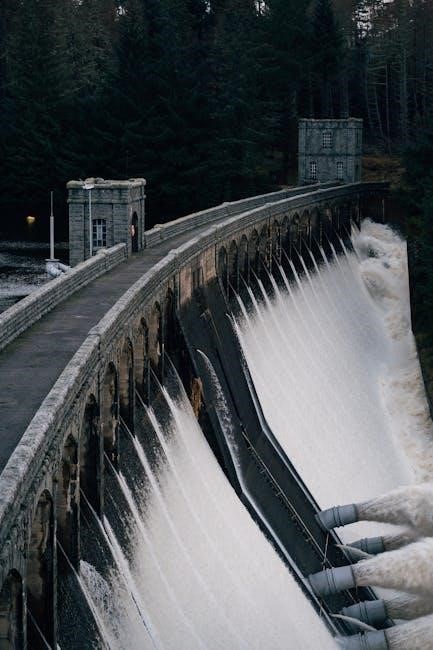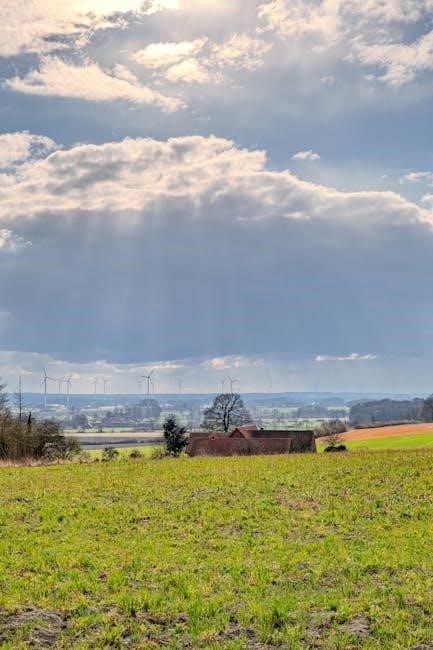Energy Worksheets PDF: A Comprehensive Guide
Energy worksheets in PDF format are invaluable resources for educators and parents. They offer structured learning experiences, covering diverse energy forms and conservation. These printables cater to various grade levels, enhancing understanding.
Energy worksheets are educational tools designed to teach children about energy concepts. Available in printable PDF format, these resources offer a hands-on way to learn about various forms of energy, including kinetic, potential, electrical, light, and thermal energy. They are commonly used in classrooms and homeschooling environments to supplement science lessons and reinforce key concepts.
These worksheets often include activities like identifying different energy sources, matching energy types to their uses, solving puzzles, completing word searches, and conducting simple experiments. The graphics and minimal terminology used in kindergarten energy worksheets make them ideal for young learners. For older students, the worksheets may involve more complex tasks, such as calculating potential and kinetic energy or exploring the environmental impacts of different energy sources.
Energy worksheets provide a fun and engaging way for children to learn about the world around them and develop an understanding of how energy plays a vital role in our daily lives. They are readily available online and can be easily customized to suit different learning styles and curriculum standards.
Types of Energy Covered in Worksheets
Energy worksheets comprehensively cover various forms of energy, providing students with a solid understanding of each type and its applications. These worksheets often delve into kinetic energy, which is the energy of motion, exploring examples like moving vehicles and flowing water. Potential energy, stored energy ready to be used, is also a key focus, with examples such as a stretched spring or an object held high.
Electrical energy, the energy associated with electric charge, is another common topic. Worksheets may cover circuits, batteries, and the flow of electrons. Light energy, also known as radiant energy, is examined through examples like sunlight and light bulbs, teaching students about the properties of light. Thermal energy, or heat energy, is explored through concepts like conduction, convection, and radiation.

Sound energy, the energy of vibrations, is often included, with activities identifying sources of sound; Nuclear energy, released from the nuclei of atoms, is sometimes introduced at higher grade levels. Worksheets might also cover renewable and non-renewable energy sources, encouraging students to think about energy conservation and environmental impact. By covering these diverse types of energy, worksheets provide a well-rounded energy education.
Energy Worksheets for Different Grade Levels
Energy worksheets are thoughtfully designed to cater to different grade levels, ensuring that the content is age-appropriate and aligned with students’ cognitive abilities. For younger learners, such as those in kindergarten and early elementary grades, the worksheets often focus on basic concepts using visual aids and simple language. These worksheets might introduce the idea of energy through familiar examples like the sun providing light and warmth, or the concept of pushing and pulling objects. Activities are typically hands-on and involve matching, coloring, and simple identification tasks.
As students progress to upper elementary and middle school, the worksheets become more complex. They delve deeper into the different types of energy, such as kinetic, potential, thermal, and electrical energy. Worksheets for these grade levels may include diagrams of circuits, explanations of energy transfer, and simple calculations involving energy. Students might also be asked to analyze real-world scenarios and identify the types of energy involved.
For high school students, energy worksheets often cover advanced topics such as thermodynamics, energy conservation laws, and the efficiency of energy conversion. These worksheets may involve complex problem-solving, data analysis, and critical thinking. They might also explore current issues related to energy production, consumption, and sustainability. By tailoring the content and complexity to each grade level, energy worksheets effectively support students’ learning and understanding of energy concepts throughout their education.
Kindergarten Energy Worksheets
Kindergarten energy worksheets introduce the fundamental concept of energy in a way that is engaging and easily understandable for young learners. These worksheets focus on familiar situations and objects to help children grasp the basic idea that energy is what makes things happen. For instance, a worksheet might feature images of the sun and shade, asking children to identify which provides warmth and light, illustrating the concept of solar energy. Similarly, a worksheet could depict a child pushing a shopping cart, demonstrating kinetic energy in action.
These early learning resources are designed to minimize reading and terminology, relying heavily on visuals and graphics to convey information. Activities often involve matching, coloring, and simple identification tasks. A worksheet might ask children to match different sources of energy, such as the sun, wind, and batteries, to the objects they power. Another activity could involve coloring pictures of items that use electricity, such as lamps and televisions.
The goal of kindergarten energy worksheets is to build a foundational understanding of energy that will support future learning in science. By presenting energy concepts in a relatable and accessible manner, these worksheets spark curiosity and encourage young children to explore the world around them with a scientific mindset. These printables serve as a valuable tool for teachers and parents looking to introduce energy concepts in an age-appropriate and engaging way. They also incorporate activities that promote critical thinking and problem-solving skills, setting the stage for future scientific exploration.
Energy Worksheets for Grades 1-3
Energy worksheets designed for grades 1-3 build upon the foundational knowledge introduced in kindergarten, delving deeper into the different forms of energy and their applications. These worksheets aim to expand students’ understanding of concepts such as light, heat, sound, electrical, and mechanical energy, presenting them in a way that is both informative and engaging. Activities often involve identifying various energy sources and matching them to their uses in everyday life. For example, students might be asked to match the sun to plants, which use solar energy for photosynthesis, or batteries to toys that require electrical energy to function.
These worksheets also introduce the concept of energy transformation, illustrating how energy can change from one form to another. Activities might include diagrams showing how a light bulb converts electrical energy into light and heat energy, or how a windmill converts wind energy into mechanical energy. Students may also be asked to identify examples of energy transformations in their own environment, such as a car converting chemical energy from fuel into kinetic energy.

In addition to these conceptual exercises, energy worksheets for grades 1-3 often incorporate hands-on activities and experiments that allow students to explore energy concepts firsthand. These activities might include building simple circuits to understand electrical energy, conducting experiments to explore heat transfer, or creating musical instruments to learn about sound energy. By combining theoretical knowledge with practical experience, these worksheets help students develop a deeper and more meaningful understanding of energy and its role in the world around them. They are a valuable resource for teachers and parents looking to enhance their students’ science education and foster a lifelong interest in STEM fields.
Free Printable Energy Worksheets and Resources
Accessing high-quality educational materials shouldn’t be a barrier to learning, which is why a wealth of free printable energy worksheets and resources are readily available for educators, parents, and homeschoolers. These resources provide a cost-effective way to supplement science lessons and engage students in exploring the fascinating world of energy. From basic concepts like identifying different forms of energy to more advanced topics such as energy transformation and conservation, there’s a worksheet to suit every learning level and curriculum need. Many websites offer a diverse collection of energy worksheets, covering topics like kinetic energy, potential energy, electrical energy, light energy, and thermal energy. These worksheets often include engaging activities like word searches, matching games, fill-in-the-blanks, and labeling exercises, making learning fun and interactive.
Beyond worksheets, numerous other free resources are available to enhance the learning experience. These include interactive games, online quizzes, and virtual experiments that allow students to explore energy concepts in a dynamic and engaging way. Videos and animations can also be valuable tools for visualizing complex processes like energy transfer and transformation. Furthermore, many educational websites offer lesson plans and teaching guides that provide educators with structured frameworks for teaching energy-related topics. These resources often include suggestions for hands-on activities, experiments, and discussion prompts that can help students develop a deeper understanding of the subject matter.
By leveraging these free printable energy worksheets and resources, educators and parents can create enriching learning experiences that spark curiosity and foster a lifelong interest in science. Whether you’re looking for a simple worksheet to reinforce basic concepts or a comprehensive lesson plan to guide your teaching, the internet offers a treasure trove of valuable materials that are just a click away.

Using Energy Worksheets in Homeschooling
Energy worksheets are incredibly versatile tools for enriching the homeschooling experience, offering a structured yet flexible approach to teaching science concepts. In the homeschooling environment, where personalized learning is paramount, energy worksheets can be tailored to suit each child’s individual learning style and pace. These worksheets can be seamlessly integrated into a broader curriculum, providing a hands-on way to explore topics like renewable and non-renewable energy sources, energy conservation, and the impact of energy consumption on the environment.
One of the key benefits of using energy worksheets in homeschooling is the ability to customize the learning experience. Parents can select worksheets that align with their child’s current understanding and gradually introduce more complex concepts as they progress. The worksheets can also be adapted to incorporate real-world examples and activities, making the learning more relevant and engaging. For instance, a lesson on solar energy could be complemented by building a simple solar oven or conducting an experiment to measure the amount of sunlight in different locations.
Furthermore, energy worksheets can be used to foster critical thinking and problem-solving skills. Many worksheets include activities that require students to analyze data, draw conclusions, and make predictions. These types of exercises help children develop a deeper understanding of the scientific method and learn how to apply their knowledge to solve real-world problems. In addition to traditional worksheets, there are also numerous online resources that can be used to supplement the homeschooling curriculum. Interactive simulations, virtual labs, and online quizzes can provide a dynamic and engaging way for children to explore energy concepts.
Interactive Energy Activities and Games
To truly engage learners and solidify their understanding of energy concepts, incorporating interactive activities and games alongside energy worksheets is highly effective. These dynamic methods transform learning from a passive exercise into an active and enjoyable experience, fostering deeper comprehension and retention. Interactive energy activities can take many forms, from hands-on experiments to digital simulations and collaborative projects. For instance, students can build simple circuits to explore electrical energy, design wind turbines to harness wind power, or create models of solar panels to understand how they convert sunlight into electricity. These activities allow students to apply their knowledge in a practical context, making the learning more meaningful and memorable.
Games provide another engaging way to teach energy concepts. Board games, card games, and online games can be designed to reinforce key ideas, such as the different forms of energy, the principles of energy conservation, and the impact of energy choices on the environment. These games often incorporate elements of competition and teamwork, motivating students to actively participate and learn from each other. Online simulations and virtual labs offer a safe and controlled environment for students to explore complex energy systems. These simulations can allow students to manipulate variables, observe the effects, and draw conclusions without the risks or limitations of real-world experiments. For example, students can simulate the operation of a power plant, experiment with different energy sources, or design a sustainable city.
By combining energy worksheets with interactive activities and games, educators can create a comprehensive and engaging learning experience that caters to different learning styles and promotes a deeper understanding of energy concepts.




